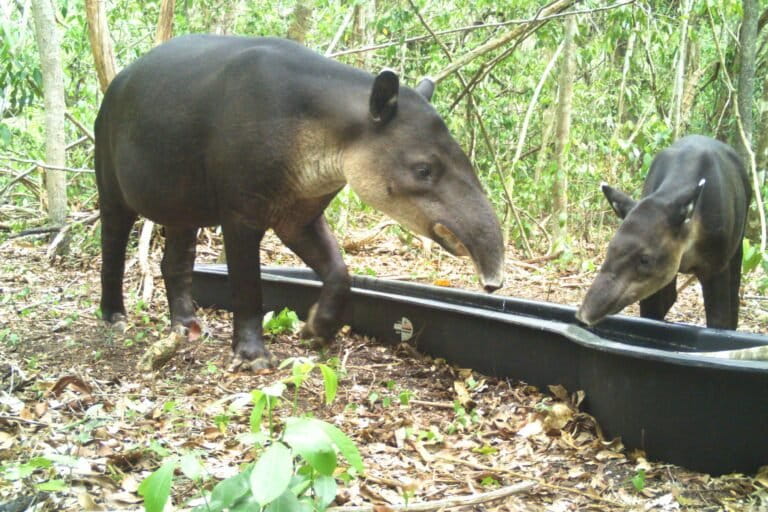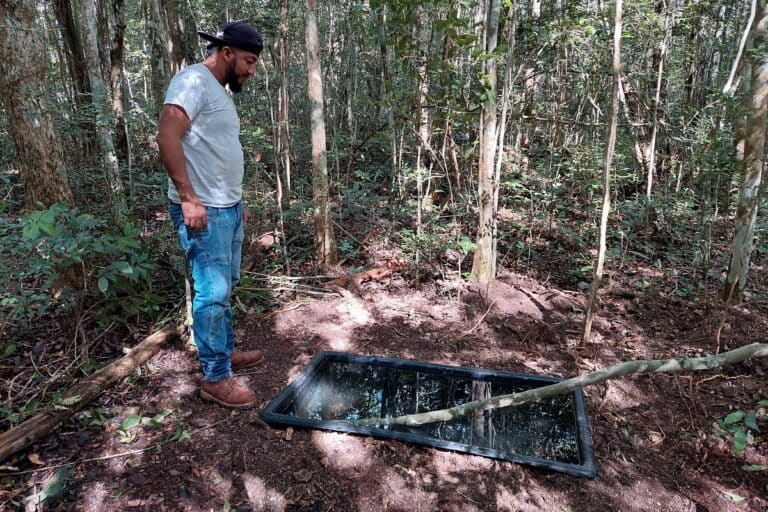- Beekeepers near the Calakmul Biosphere Reserve are working with conservationists to provide water troughs for wild animals in an effort to reduce conflicts with farmers and livestock.
- More than 70 species, including Baird’s tapir, jaguars (Panthera onca), ocelots (Leopardus pardalis) and coatis (genus Nasua), have used the troughs as climate change exacerbates water shortages in the biosphere during the dry season.
- Conservationists caution that such projects must be implemented carefully so as not to introduce pathogens into the wild or create “predator traps” where wild carnivores’ prey congregate around artificial water sources.
Like many beekeepers living in the vicinity of the Calakmul Biosphere Reserve, Alejandro Oliveros López has a wildlife problem. To keep ants at bay and provide water to their bees, keepers place bowls at the foot of their apiaries. But when water is scarce, these attract a wide range of wild animals, from tapirs to wild cats. Driven by climate change, this issue keeps worsening as the dry season gets longer.
“Basically, they drink the water, because during the dry season, the natural water sources dry up,” Oliveros López said. “So, if a tapir comes, drinks the water and knocks over the tank to bathe itself, it can cause us a lot of problems. The cats are the same because they drink a lot of water.”
To help reduce this problem and protect both wildlife and beekeepers’ livelihoods, conservationists are using water troughs, known locally as bebederos, to keep wildlife from coming into conflict with farmers.
“The idea of the project is that we provide water to both the bees and the animals, and try to avoid these kinds of problems,” said Carlos Delgado-Martínez, a PhD student with the National Autonomous University of Mexico and member of the Ocelot Working Group, whose team is implementing water troughs. “We’re placing the bebederos near the apiaries but not close enough that the animals get too close.”
Calakmul’s water conflict
The Calakmul Biosphere Reserve is one of Mexico’s largest protected areas, covering more than 700,000 hectares (approximately 1.8 million acres). Since the reserve doesn’t have any rivers or lakes, water often runs short. During the rainy season rainfall concentrates in spots known as aguadas, seasonal lakes, and sartenejas, small rock pools, which become a lifeline for wildlife in the protected area.

These natural water sources are increasingly affected by climate change, which is disrupting rainfall regimes in Calakmul.
Though average rainfall levels are not thought to be decreasing in Calakmul, they became more unpredictable and extreme, according to experts.
“What is happening is that the aguadas dry up more frequently,” Delgado-Martínez said.
This situation came to a head in 2019, explained Fernando Contreras-Moreno, a biologist with WWF-Mexico. That year, the region had one of the lowest recorded annual rainfalls in the previous decade and an extended period of drought. Species such as Baird’s tapir (Tapirus bairdii) and a host of other wildlife encroached upon farmers’ lands and villages in the search for water. Many showed clear signs of dehydration, he said.
In a study published in 2021, researchers warned that this conflict posed a conservation threat to Baird’s tapir. Wildlife veterinarian Jonathan Pérez-Flores, who co-authored the paper and has worked in Calakmul for more than a decade, explained that he and his team found tapirs with bullets in their skulls. Though it wasn’t certain, one hypothesis was that at least some were killed in retaliation for damage to crops or apiaries. Scarcity of water was also recognized as a threat to other species such as the white-lipped peccary (Tayassu pecari).
Since then, Pérez-Flores has conducted further research and he said he believed that, in addition to the extended drought of 2019, natural and artificial fires — started mainly as part of slash-and-burn agriculture — may also have contributed to the situation. This research is ongoing, he said.
Human-wildlife conflict was already a long-standing issue in Calakmul. Wild cats, for instance, sometimes prey upon livestock in the region. According to Contreras-Moreno, the scarcity of water could worsen this problem. “Carnivores, like the jaguar, can cover a lot of ground, and on top of looking for food, they search for water,” Contreras-Moreno said. “So, if there’s no water in the forest, the only water available is that used by beekeepers or farmers. The water sources become a magnet for animals.”
Beyond Calakmul, climate change is set to increase such cases of conflict across the world, experts warned in a recent paper.
Bebederos: A replicable solution
In 2015, six water containers were placed in the Calakmul Biosphere Reserve as a pilot. Now, Contreras-Moreno said, WWF-Mexico and its partners manage around 50 of them inside the protected area. A further 25 are placed in the surrounding area and managed by beekeepers during the dry season.

A protocol has been developed, including monitoring of the water troughs using camera traps to understand which animals are using them and with what frequency. More than 70 species, including Baird’s tapir, jaguars (Panthera onca), ocelots (Leopardus pardalis) and coatis (genus Nasua), have been recorded using the troughs.
The Ocelot Working Group’s project is one of several in the area and has so far installed three water troughs in partnership with eight beekeepers. Delgado-Martínez said using wildlife species such as the ocelot as a flagship species could help bring farmers on board. “We have an idea that the beekeepers who are implementing this system could use a label such as ‘wildlife-friendly honey.’”
“It’s not important who does it, but that it is done. Because working alone, the government, WWF or other organizations can’t cover the whole area,” Contreras-Moreno said. Though the model is relatively simple, it is not without its challenges. Transporting the water can be a monumental task, he noted, especially if it has to be brought from as far away as 100 kilometers (62 miles) in particularly dry periods. “What we have to achieve is that the [local and national] governments include actions such as this in their national conservation and sustainable development plans.”
Yet, the solution has proved somewhat controversial, particularly when it comes to placing bebederos within the reserve itself.
Pérez-Flores said extreme caution is required. He acknowledged that solutions to water scarcity conflicts are limited, but is concerned about the possible introduction of pathogens into the wild, particularly when water is transported long distances. In addition, these artificial water sources could change ecosystem dynamics by creating “predator traps” in the protected area as carnivores’ prey congregate around the artificial water sources, meaning that thorough monitoring is needed, he added.

Guaranteeing that the forest has sources of water during the dry season, however, “can at least help reduce the possibility that these animals become a problem for people living and working in the area,” Contreras-Moreno told Mongabay. “If we don’t have this problem, we can reduce the mortality of key species like the tapir or jaguar.”
Despite the challenges of implementing such projects, it’s a solution that local beekeepers see value in. Though the water trough was only installed near his bees earlier this year, beekeeper José Antonio Cruz Hernández said it appeared to be working: “The water lasts longer in the apiaries, and I don’t have to worry about the ants attacking the apiaries,” he said. “It is important because I protect both species, bees and felines.”
Citations:
Mardero, S., Schmook, B., Christman, Z., Metcalfe, S. E., & De la Barreda-Bautista, B. (2019). Recent disruptions in the timing and intensity of precipitation in Calakmul, Mexico. Theoretical and Applied Climatology, 140(1-2), 129-144. doi:10.1007/s00704-019-03068-4
Pérez-Flores, J., Mardero, S., López-Cen, A., & Contreras-Moreno, F. M. (2021). Human-wildlife conflicts and drought in the greater Calakmul region, Mexico: Implications for tapir conservation. Neotropical Biology and Conservation, 16(4), 539-563. doi:10.3897/neotropical.16.e71032
Sanchez-Pinzón, K., Reyna-Hurtado, R., Naranjo, E. J., & Keuroghlian, A. (2020). Peccaries and their relationship with water availability and their predators in Calakmul, Mexico. Therya, 11(2), 213-220. doi:10.12933/therya-20-878
Banner image: Photo by Gerardo Ceballos.
